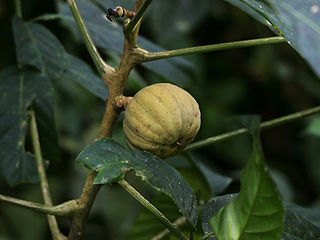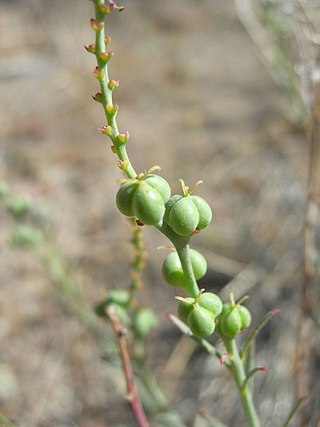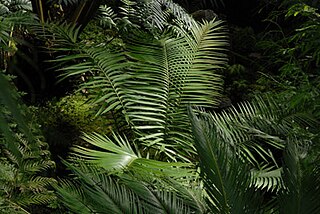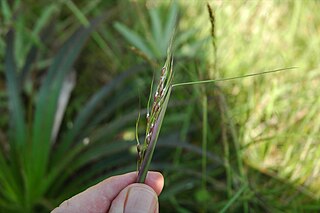
Milla, the Mexican star, is a genus of monocotyledonous plants in the family Asparagaceae, subfamily Brodiaeoideae. They are native mostly to Mexico, with one species extending into Guatemala, Honduras, Arizona, Texas and New Mexico.

Zamia is a genus of cycad of the family Zamiaceae, native to North America from the United States throughout the West Indies, Central America, and South America as far south as Bolivia. The genus is considered to be the most ecologically and morphologically diverse cycads, and is estimated to have originated about 68.3 million years ago.

Tigridia, is a genus of bulbous or cormous flowering plants belonging to the family Iridaceae. With common names including peacock flowers, tiger-flowers or shell flowers, they have large showy flowers; and one species, Tigridia pavonia, is often cultivated for this. The approximately 35 species in this family grow in the Americas, from Mexico to Chile. The tigridia flower is short lived, each often blooming for only one day, but often several flowers will bloom from the same stalk. Usually they are dormant during the winter dry-season. The roots are edible and were eaten by the Aztecs of Mexico who called it cacomitl, and its flower ocēlōxōchitl "jaguar flower". The genus name Tigridia means "tiger-like", and alludes to the coloration and spotting of the flowers of the type species Tigridia pavonia.

Sebastiania is a genus of flowering plants in the family Euphorbiaceae first described in 1821. It is native to North and South America from Arizona and the West Indies south to Uruguay.
Wielandia is a genus of flowering plant, of the family Phyllanthaceae first described as a genus in 1858. The plants are native to Kenya, Madagascar, and to various other islands in the Indian Ocean.

Cnidoscolus is a plant genus of the family Euphorbiaceae first described as a genus in 1827. The group is widespread across much of North and South America, including the West Indies.
Bernardia is a plant genus of the family Euphorbiaceae first described for modern science as a genus in 1754. It is native to North and South America, as well as the West Indies.

Caperonia is a genus of plants of the family Euphorbiaceae first described as a genus in 1825. The genus is native to tropical and subtropical America and Africa.

Ditaxis is a plant genus of the family Euphorbiaceae first described as a genus in 1824. Its name comes from Greek dis ("two") and taxis ("rank"), referring to the stamens which are in two whorls. The genus is widespread across much of the Western Hemisphere from the southern United States to Uruguay.

Hura is a genus of trees in the family Euphorbiaceae described by Carl Linnaeus in 1753. It is native to South America, Mesoamerica, and the West Indies.

Stillingia is a plant genus of the family Euphorbiaceae, first described for modern science as a genus in 1767. The genus is native to Latin America, the southern United States, and various islands in the Pacific and Indian Oceans. Toothleaf is a common name for plants in this genus.
Ophellantha is a genus of plants under the family Euphorbiaceae first described as a genus in 1924. It is native to southern Mexico and northern Central America.
- Ophellantha spinosaStandl. - Honduras, El Salvador, Chiapas, Veracruz
- Ophellantha steyermarkiiStandl. - Guatemala, Chiapas
Astrocasia is a plant genus of the family Phyllanthaceae first described as a genus in 1905. It is included in the subtribe Astrocasiinae. It is native to Mesoamerica, northern South America, and the western part of the West Indies. Plants are mostly dioecious, except for Astrocasia diegoae which is monoecious, and some individuals of A. neurocarpa and A. tremula.
- Astrocasia austinii(Standl.) G.L.Webster - Izabal
- Astrocasia diegoaeJ.Jiménez Ram. & Mart.Gord. - Guerrero
- Astrocasia jacobinensis(Müll.Arg.) G.L.Webster - Bahia, Bolivia
- Astrocasia neurocarpa(Müll.Arg.) I.M.Johnst. ex Standl. - Oaxaca, Querétaro, San Luis Potosí, Tamaulipas
- Astrocasia peltataStandl. - Costa Rica, Nayarit, Jalisco
- Astrocasia tremula (Griseb.) G.L.Webster - Mexico, Central America, West Indies, northern South America

Ceratozamia is a genus of New World cycads in the family Zamiaceae. The genus contains 27 known currently living species and one or two fossil species. Most species are endemic to mountainous areas of Mexico, while few species extend into the mountains of Guatemala, Honduras and Belize. The genus name comes from the Greek ceras, meaning horn, which refers to the paired, spreading horny projections on the male and female sporophylls of all species.

Paul Carpenter Standley was an American botanist known for his work on neotropical plants.

Piptochaetium, or speargrass, is a genus of plants in the grass family, native to North and South America. Piptochaetium is a bunchgrass genus in the tribe Stipeae.
Billbergia viridiflora is a plant species in the genus Billbergia native to Tabasco, Belize and Guatemala.

Weldenia is a monotypic genus of flowering plants in the family Commelinaceae, first formally described in 1829. It has one single species: Weldenia candida, which grows natively in Mexico and Guatemala.

Limnobium, common names spongeplant and American frogbit, is a group of aquatic plants in the Hydrocharitaceae described as a genus in 1814. It is widespread in freshwater environments in Latin America, the West Indies, and the United States.

Cathestecum is a genus of the North American plants in the grass family.














